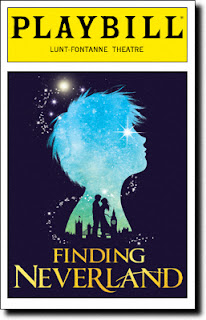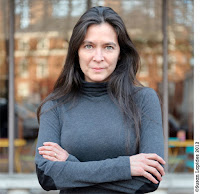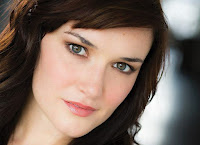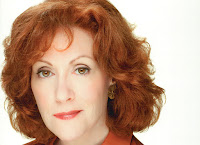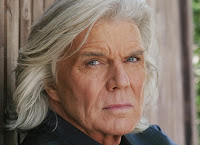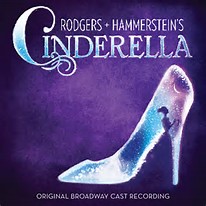The Many Versions of the Addams Family
by Paula Gail Benson
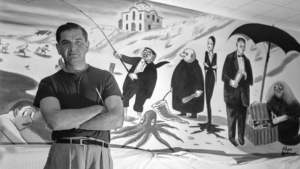
Mural with Charles Addams from: The Addams Family Secret | The New Yorker
According to Wikipedia, Charles Samuel Addams (January 7, 1912-September 29, 1988) made a career as a cartoonist, first for his high school yearbook, then as a free-lancer for The New Yorker as well as a stint creating animated training films for the Army during World War II. He had a macabre outlook, was drawn to a Presbyterian Cemetery as a child, and, as inspiration for the Addams home, explored mansions in the town where he grew up (one of which he was accused of breaking and entering) and buildings at the colleges he attended.
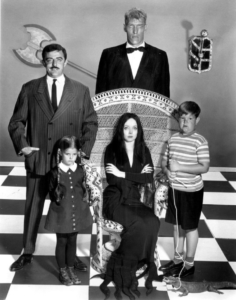
From the 1964-66 ABC TV series
The cartoon characters with which he is most often identified remained nameless in the New Yorker until they became the basis of a situation comedy, The Addams Family, a television program filmed in black-and-white that initially aired from 1964-66. John Astin played the effusive Gomez Addams who passionately adored his beloved wife Morticia (Carolyn Jones), always moving incrementally in a black, tight-fitting, V-necked gown. Their butler, the deep-voiced, tall, and intimidating Lurch (Ted Cassidy) was originally written to be mute, but when Cassidy ad-libbed “You rang?”, the phrase was immediately adopted as the character’s signature line. Bald Uncle Fester (Jackie Coogan) was identified as Morticia’s uncle and Grandmama Addams (Blossom Rock) as Gomez’ mother. Pugsley (Ken Weatherwax) and Wednesday (Lisa Loring) were the two children. Charles Addams originally wanted to call Pugsley “Pubert,” but that name was rejected as being too sexual. Later, in the film Addams Family Values, the new baby and third child was called Pubert.
Several animated and live action series featured the family in the 1970s and 1990s. One of the animated series had Jodie Foster voicing Pugsley. In 2022, Netflix presented Wednesday, a supernatural coming of age series that had a teen aged Wednesday Addams solving a murder at her school.
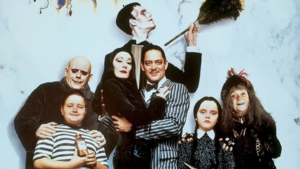
From Barry Sonnenfeld’s The Addams Family movie (1991)
A number of films, both live action and animated, have focused on the family’s adventures. In 1991 and 1993, Barry Sonnenfeld directed The Addams Family and Addams Family Values. (Barry Sonnenfeld also appeared in Addams Family Values, as the father of Joel Glicker, Wednesday’s boyfriend at Camp Chippewa.) Raul Julia played Gomez Addams with Anjelica Huston as Morticia. Christopher Lloyd is Fester, who was identified as Gomez’ brother. Morticia referred to Grandmama (Judith Malina in the first film and Carol Kane in the second) as her mother (with a mention in the first film that Gomez’ parents were dead). Interestingly, in the Broadway musical, The Addams Family (2010), when Morticia said Grandmama was Gomez and Fester’s mother, Gomez (played by Nathan Lane) was surprised, saying he thought she was Morticia’s mother. Morticia (played by Bebe Neuwirth) later admitted that Grandmama might not be a member of the family. (Note, Nathan Lane appeared in the movie Addams Family Values, as a beleaguered police officer listening to Gomez demand an investigation of Debbie Jellinsky (played by Joan Cusack), who married Fester and established their home in the suburbs.)
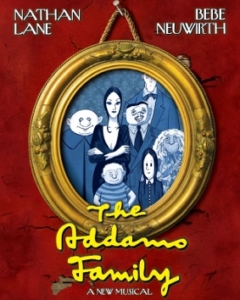
Poster for Broadway musical The Addams Family
In the Sonnenfeld films, while Pugsley (Jimmy Workman) might be older, Wednesday (Christina Ricci) definitely showed greater malevolent initiative. In The Addams Family, when a Girl Scout (Mercedes McNab) asked if their lemonade was made with real lemons, Wednesday inquired if her cookies were made with real Girl Scouts. McNab returned in the role of Amanda Buckman in Addams Family Values, a camper who ridiculed and later was tormented by Wednesday and Joel Glicker (played by David Krumholtz, who went on to star in the TV show Numb3rs).
For the 2010 Broadway musical, The Addams Family, Wednesday (Krysta Rodriguez) is the older of the two siblings, pleading with her parents for “One Normal Night” for the family to meet her boyfriend (Wesley Taylor) and his parents (Terence Mann and Carolee Carmello).
The Penn State Library now displays a mural painted by Charles Addams for a Hamptons hotel. The mural was donated to the college when the hotel property changed hands. Entitled “An Addams Family Holiday,” it features the group at the beach, enjoying the waves that other vacationers are fleeing. Meanwhile, Lurch and Grandmama prepare a picnic lunch of bats and a mixed drink made with poison. All very appropriate for a Halloween celebration!
BTW, did you know that Charles Addams received an Edgar Award from the Mystery Writers of America?

Mural from: The Addams Family Secret | The New Yorker

